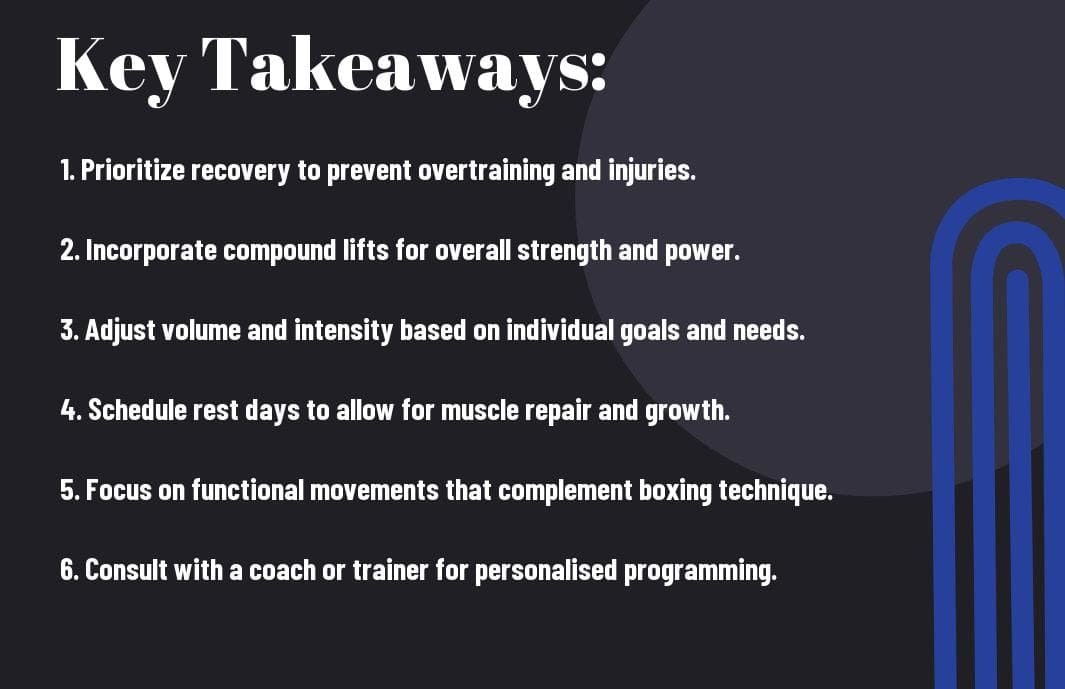If you’re a keen boxer looking to maximise your performance and keep your body in optimum condition, finding the right balance between boxing training and strength training is crucial. Whilst both disciplines are essential for your progress, it can be a challenging task to strike the perfect balance. In this blog post, we will explore the key considerations and practical tips for incorporating effective strength training alongside your boxing regime. Whether you’re a professional fighter or a hobbyist, finding the right balance will ensure you are at the peak of your game.
Key Takeaways:
- Plan your schedule: Create a training schedule that allows time for both boxing and strength training, prioritising boxing sessions for technique and endurance and strength training for muscle building and injury prevention.
- Focus on recovery: Proper rest and recovery are essential for progress and injury prevention, so make sure to incorporate rest days and active recovery exercises into your routine.
- Combine workouts: Look for opportunities to combine boxing and strength training exercises to save time and improve overall athleticism, such as incorporating bodyweight exercises and using resistance bands during boxing sessions.
- Customise your approach: Tailor your training to fit your specific goals and needs, whether that means focusing more on boxing technique or dedicating more time to strength training, prioritise what is most important to you.
- Seek professional advice: Consider hiring a coach or personal trainer who can help you create a balanced training plan that aligns with your goals and maximises your potential in both boxing and strength training.

Understanding the Fundamentals
When it comes to balancing boxing training with strength training, it’s crucial to have a solid understanding of the fundamentals of both disciplines. This will help you tailor your workouts to suit your individual needs and maximise your performance in the ring.
Key Principles of Boxing Training
Boxing training focuses on developing speed, power, and endurance while honing technical skills such as footwork and hand-eye coordination. It involves a combination of bag work, pad work, sparring, and conditioning exercises to improve your overall boxing performance. In addition to physical conditioning, boxing training also requires mental discipline and tactical awareness.
Core Elements of Strength Training
Strength training is aimed at improving muscular strength, power, and endurance to enhance athletic performance. This type of training involves lifting weights, performing bodyweight exercises, and using resistance equipment to target specific muscle groups. Incorporating strength training into your regimen can help you develop the explosiveness and resilience needed for boxing, in addition to reducing the risk of injury by strengthening supporting muscles and enhancing overall physical resilience.
Designing the Balanced Training Program
When it comes to balancing boxing training with strength training, it’s important to create a well-rounded and effective training program. This involves assessing your training needs and goals, as well as creating a synergistic week-by-week schedule that allows you to make progress in both areas.
Assessing Training Needs and Goals
Before you can design a balanced training program, it’s important to assess your specific training needs and goals. Evaluate your current level of boxing skills and overall fitness, as well as your strength and conditioning levels. Determine which aspects of your training need improvement and set clear, realistic goals for both your boxing and strength training. This will help you tailor your training program to address your specific needs and work towards achieving your desired results.
Creating a Synergistic Week-by-Week Schedule
Once you’ve identified your training needs and goals, it’s time to create a synergistic week-by-week schedule that allows you to effectively balance your boxing and strength training. Plan your training sessions in a way that optimises your performance in both areas without overtraining or neglecting any aspect. This may involve incorporating boxing drills, technique work, strength training exercises, and recovery sessions into your weekly schedule. By carefully planning and scheduling your training sessions, you can ensure that you make progress in both boxing and strength training while minimising the risk of overtraining and injury.
It’s essential to ensure that each training session and exercise complements the other, allowing for optimal progress. Integrate adequate rest and recovery days into your schedule to allow your body to repair and adapt to the training stimulus. This will help prevent burnout and reduce the risk of injury, ultimately supporting your overall progress and performance.
Practical Tips for Integration
When integrating boxing training with strength training, it is important to approach it strategically to ensure you get the most out of both disciplines. Here are some practical tips to help you effectively balance your workout routine:
- Plan your schedule: Allocate specific days for boxing training and strength training, and avoid doing intense sessions of both disciplines on consecutive days.
- Adjust intensity: Depending on your goals, you may need to modify the intensity of your workouts. For example, if you have a heavy boxing session in the morning, you may want to lighten the load for your strength training session in the evening.
- Focus on recovery: Ensure you get enough rest, sleep, and recovery time between sessions to prevent overtraining and injury.
- Listen to your body: Pay attention to how your body responds to the dual training and make adjustments accordingly. Pushing through fatigue can do more harm than good.
The integration of two different training disciplines may seem challenging, but with the right approach, you can effectively balance both and maximise your performance.
Managing Fatigue and Recovery
Managing fatigue and prioritising recovery is crucial when balancing boxing training with strength training. You must be attuned to your body’s signals and be willing to adjust your training schedule or intensity when necessary. Ignoring signs of exhaustion can lead to overtraining, risking injury and hindering your progress. Adequate rest, quality sleep, and listening to your body are essential for optimal recovery.
Nutrition and Supplementation for Dual Training
When engaging in both boxing training and strength training, your nutrition becomes even more critical. You need to fuel your body with the right balance of macronutrients to support your performance and recovery. Additionally, considering the use of supplements, such as protein powders and amino acids, may help fill in any nutritional gaps and support your training demands.
Advanced Techniques and Considerations
- Periodization Strategies for Optimal Performance – This advanced technique involves breaking down your training into specific time periods, with each period focusing on different aspects of your physical development. For example, you may have a period dedicated to building strength, followed by a period focusing on power development, and then a period for skill refinement. This method allows for more targeted training and can lead to greater overall improvements in performance.
- Monitoring Progress and Adjusting the Program – It’s important to regularly assess your progress and make adjustments to your training program as needed. This may involve tracking your performance in the boxing ring, monitoring your strength gains in the gym, or even undergoing regular fitness testing. By staying on top of your progress, you can ensure that your training remains effective and that you continue to make gains in both boxing and strength.
Periodization Strategies for Optimal Performance
When it comes to balancing boxing training with strength training, periodization can be a game changer. By breaking down your training into specific phases, you can optimise your physical development and ensure that you make consistent progress in both areas. You can focus on building strength, power, and skill at different times, allowing for more targeted and effective training.
Monitoring Progress and Adjusting the Program
Regularly assessing your progress and making adjustments to your training program is crucial for optimal performance. By monitoring your performance and making changes as needed, you can ensure that your training remains effective and that you continue to make gains in both boxing and strength. This approach allows you to stay on track and maximise your potential in both areas.
How Can I Balance Boxing Training With Strength Training?
Taking this into account, it’s important to find a balance between your boxing training and strength training in order to maximise your performance in the ring. Incorporating a structured schedule that includes both forms of training, while also allowing time for rest and recovery, is key. You should focus on compound exercises that target multiple muscle groups, as well as high-intensity interval training to build endurance and explosiveness. Remember to listen to your body and adjust your training regimen as needed to prevent overtraining and injury. By carefully balancing your boxing and strength training, you can improve your overall athletic performance and achieve your fitness goals.
FAQ
Q: Is it possible to balance boxing training with strength training?
A: Yes, it is possible to balance boxing training with strength training by carefully designing a training program that incorporates both disciplines without overloading the body.
Q: How often should I incorporate strength training into my boxing training schedule?
A: Ideally, you should aim to incorporate strength training into your boxing training schedule 2-3 times per week, allowing for adequate rest and recovery in between sessions.
Q: What type of strength training exercises are best for boxers?
A: Strength training exercises for boxers should focus on functional movements and compound exercises that target the major muscle groups used in boxing, such as squats, deadlifts, pull-ups, and core exercises.
Q: Should I focus more on cardio or strength training for boxing?
A: Both cardio and strength training are important for boxing, but it is essential to strike a balance between the two. While cardio improves endurance, strength training enhances power, speed, and overall performance in the ring.
Q: How can I prevent overtraining when balancing boxing and strength training?
A: To prevent overtraining, it is crucial to listen to your body, get adequate rest, and carefully plan your training program to avoid excessive strain on your muscles and central nervous system.
Q: Can I do strength training on the same day as boxing training?
A: Yes, it is possible to do strength training on the same day as boxing training, but it is important to prioritize the session that is most essential to your goals and to allow sufficient recovery time between workouts.
Q: What are the benefits of balancing boxing training with strength training?
A: Balancing boxing training with strength training can lead to improved overall athletic performance, increased power and speed, reduced risk of injury, and enhanced muscular endurance, all of which are crucial for success in the sport of boxing.



